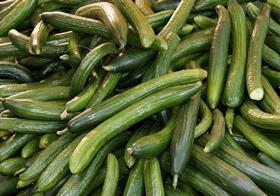
It’s been a trying period for those involved in cucumber supply. With retail prices showing no signs of supporting the long-term growth of the category, there are fears over what lies in store.
Luke Hibberd, chairman of the Cucumber Growers’ Association (CGA) and commercial director at Abbey View Produce, says: “There is major concern as to why cucumber seems to be the ‘new banana’ in price wars. In fairness the major cuts in margin have been taken by the retailers, with the growers being semi-protected from the cuts by their marketing companies.
“However, given the low margins already in place, further strain is being put on this iconic British crop. There has been much talk recently about the crop becoming unsustainable and a small increase in returns to growers would renew confidence and allow shelved re-investment plans to be progressed.”
Growers are taking matters into their own hands, though – high-wire crops are reportedly becoming more commonplace in the industry, with new growers making the required alterations to older greenhouses each year. Hibberd notes: “With the devalued retail price point and the lack of funds for major re-investment, these smaller changes are proving more significant and important for the smaller-scale independent growers.”
Nevertheless, it hasn’t stopped growers moving onto looking at other crops. Lee Stiles, of Lea Valley Growers’ Association, says: “Current price levels are unsustainable, and this, combined with the increase in input costs brought about by the National Living Wage and pension contributions, has already seen a move away from cucumbers in respect of new glasshouse developments in the Lea Valley, with all 50 acres under development earmarked for peppers and tomatoes.”
Hibberd cites the upcoming introduction of the National Living Wage – which will see workers in the UK aged over 25 earning the minimum rate of £6.70 per hour get a 50p increase – as being a cause for concern, along with chancellor George Osborne’s new apprenticeship levy of 0.5 per cent on company payrolls: “It all adds cost to a product already working on a shoestring, which leads to a real concern that current retails need to be increased to allow for a sustainable future.”
Both demand and supply, at least, have been strong throughout the winter season. Stiles says: “Retailers have seen the consumption and demand for cucumbers reach their highest levels since price reductions, with some unable to meet consumer demand.” Hibberd points out that although the reduced retail prices and returns are undesirable, without the volume uplift the product has received, “things could have been worse”.
They may yet be in coming years: “Of course, had El Niño produced an unseasonable cold winter opposed to warm, we would have seen major crop shortages exasperated by the increased demand. This is a major risk, and could cause many suppliers issues when arranging next winter’s seasonal costs,” Hibberd says.
Work is ongoing to target the next generation of consumers, though. Stiles says: “Unlike other sectors, cucumber-growing levy payers do not appear to benefit from any kind of consumer promotion, and take it upon themselves to open their nurseries to local schools and through retailer initiatives to teach pupils where their food comes from.”
Hibberd adds: “As chairman of the CGA, we will be continuing the initiative set up by the previous chairmen of working with the Great British Chefs (GBC) organisation, to create a promotional campaign aimed at cross-selling cucumbers and introducing them as an accompaniment and key ingredient to a greater variety of meals.
“This will be supported through use of the GBC social media tools, a new association website targeted at the end consumer, and we will also be asking members to arrange promotions with their customers to coincide with the timings of the online activity.”
Hibberd – who also wants suppliers to explore further opportunities for cucumbers via the processed fresh food market and as an ingredient in the pharmaceutical industry – doesn’t want to take on this challenge by halves either: “Work needs to be done to understand the modern consumer across the fresh produce industry, and it is the intention of the CGA to make up for lost ground and progress to leaders in this area.”
Fighting talk indeed. But having been through the wire in recent years, cucumbers aren’t going to bounce back and grow by hiding meekly in the corner.
The foodservice view
Mike Attwood, purchasing and supply chain director at EIPC, which supplies Subway franchises with their fresh produce, says: “Thewarm weather in Spain has resulted in plants producing fruit early, and means that availability overall has been good so far this season.This means that market prices have been normal to low compared to the last few years, although market prices have risen over the last week or so as many growers are in between crops. This affects availability and also quality if growers pick fruit from the old plants.” He notes that, on the whole, quality has been “very good” recently, albeit with some suppliers reporting that the warmer weather has resulted in some soft fruit.
The wholesale view
“Wholesale markets are developing a new desire for smaller fruit, so longer count boxes of 14 and 16,” Hibberd tells FPJ. “This enables keen piece prices, and the inclusion within the fast developing ‘bowl trade’ being adopted throughout independent retailers.” He adds that the large cash and carries still have a desire for the larger fruit, but again, “they require lower costs to put them in a competitive position against the high street.”



